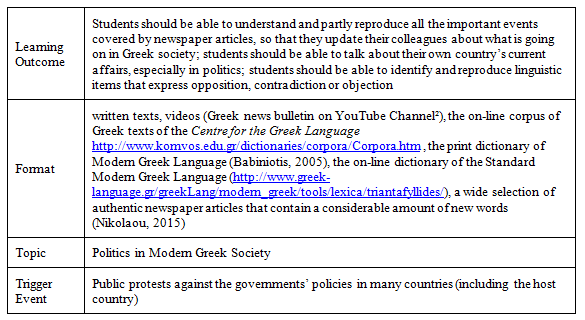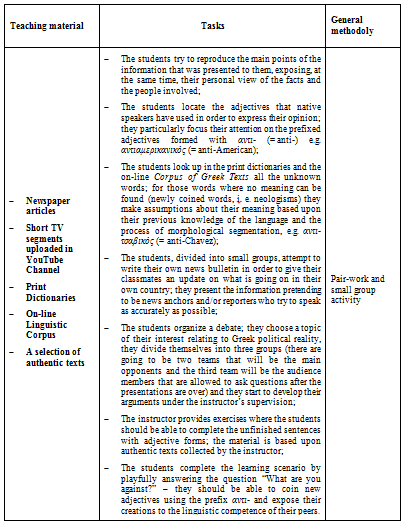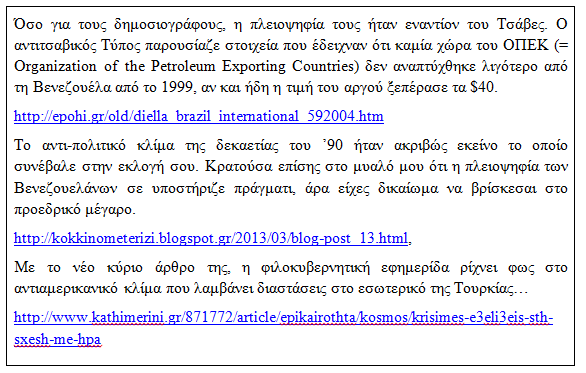Neologisms and greek language teaching as a foreign language
Georgia NIKOLAOU, Aristotle University of Thessaloniki, Greece
Résumé
Il a déjà été souligné dans la littérature internationale que plus les élèves ou les apprenants d’une langue étrangère connaissent de vocabulaire, plus leur niveau linguistique est élevé et plus leur niveau de réussite académique et sociale l’est également (Stahl & Nagy, 2006, Carlisle, 2007, Anastassiadis-Symeonidis, 2003, Anastassiadis-Symeonidis et al. 2014). Le but de ce travail est de montrer que l’emploi des néologismes dans l’enseignement de la langue grecque comme langue étrangère devrait être intégré dans les pratiques et les méthodologies actuelles. Nous allons, ainsi, essayer de présenter un scénario pédagogique (Iordanidou & Papaioannou, 2014) dans le cadre de l’enseignement basé sur le contenu chez les apprenants avancés du grec comme langue étrangère. Nous prétendons que l’emploi des néologismes mène les apprenants à une connexion plus profonde avec la langue-cible, tout en leur offrant des connaissances fondamentales sur les normes sociales de la nouvelle communauté linguistique.
Enseignement - Enseignement basé sur le contenu - Langue seconde/étrangère - Néologismes
Abstract
It has already been pointed out in the international literature (Stahl & Nagy, 2006, Carlisle, 2007, Anastassiadis-Symeonidis, 2003, Anastassiadis-Symeonidis et al., 2014) that vocabulary learning is vital for the students’ linguistic development, whether it is for the teaching of the mother language or for the acquisition of a second or foreign language. The aim of this paper is to prove that the use of neologisms in Greek language teaching as a foreign language should be integrated into current teaching methodologies. Based on a wide selection of real newspaper articles that contain a considerable amount of new words (loans, compound lexical units and derived words), we shall try to present and thoroughly describe a teaching scenario (Iordanidou & Papaioannou, 2014) within the approach of content-based instruction addressing to advanced learners of Modern Greek language as a foreign language. Our final conclusion is that with the successful implementation of neologisms in language teaching not only do students develop a deeper connection with the target language, but they also acquire extremely useful knowledge about the cultural norms of a different linguistic community.
INTRODUCTION
In the first part of my article I shall try to describe three important components in the acquisition of vocabulary of a second/foreign language: (a) the practice of morphological processing, (b) the benefits of task-based and content-based teaching which involve the extensive use of newspaper articles and texts, i.e. authentic texts, written in the target-language and (c) the building of academic vocabulary, which is an essential part of academic background knowledge. In the second part of the article I shall try to demonstrate how these three parameters meet in the field of neology and how a selection of newly coined words in the target language can serve as educational material for language teaching.
1. THE ACQUISITION OF VOCABULARY
It has been pointed out in international literature that “learning new words is foundational to success in school” (Stahl & Nagy, 2006: vii). The number of words that a foreign student knows is an indicator of how well that student will perform in his academic tasks as well as how effectively he will adjust in his new social and cultural environment, something that can be an interesting but also extremely challenging process. Students use the words of a target-language (a) to communicate with native speakers & (b) understand, interpret, describe and handle their new social and cultural reality. “Hence, having a large vocabulary is both a powerful tool for a variety of academic and life goals” (Stahl & Nagy, 2006: vii).
A language instructor has to answer some crucial questions like:
(a) what are the parameters that need to be taken into account in order to select the most useful part of the vocabulary?
(b) which teaching strategies should be used by the language instructor so that student learning will be improved?
(c) what can be the role of segmenting the words into morphemes, the smallest meaning-bearing elements of natural languages? Can morphological processing be a component in vocabulary learning and comprehension of texts?
(d) how can the use of contemporary and updated tools of linguistic data (linguistic corpora, on-line dictionaries) contribute to second/foreign language learning?
(e) how can the introduction of neologisms, i.e. linguistic units that have not yet been fully accepted into mainstream language, enhance the acquisition of vocabulary?
1.1. Morphological segmentation
Previous studies carried out for the English, the French and other languages (Carlisle, 2007, McBride-Chang et al., 2007, Colé, 2011) have shown that morphological segmentation can help the students decode the texts used in the classroom, both oral and written, and also make them understand how new words are coined in the target language. Using morphological processing strategies can enhance the reading competence of the students and make them more active outside the classroom. An early study for the English by Nagy & Anderson (1984) has shown that almost 60% of the words used in course books are derived words, the meaning of which can be largely predicted by the meanings of the component morphemes which were combined to form them. This interesting observation can also be true for Greek, which has a rich inflectional and derivational system. Furthermore, according to Anastassiadis-Symeonidis (2003), the correct segmentation of the constructed words, i.e. the words which have internal structure, can help students improve their spelling skills.
According to Anastassiadis-Symeonidis & Mitsiaki (2010) the strategy of morphological segmentation can prove particularly useful in the teaching of Greek as a foreign language, as it (a) combines language processing with the evaluation of the lexical meaning, (b) has memory-preserving effects on students and (c) helps students comprehend the way new words are coined in the target language. The important question that arises out of this discussion is where language instructors will focus their attention on. Anastassiadis-Symeonidis (2003: 26) has proposed four useful criteria: (a) the prototypicality of the linguistic item, i.e. whether it belongs in one of the central categories of the system. In the case of newly coined adjectives, for example, derived adjectives formed with the suffix -ικός, which constitutes the most common derivational suffix used to form adjectives in Modern Greek (Nikolaou, 2015), would be the first to be taught to foreign students of Greek; (b) the token frequency of the linguistic item, which is estimated by the total number of its occurrences in the source texts (e.g. the course books). An excellent example would be that of the prefix α-, which is frequently found in prefixed adjectives; (c) the availability of the linguistic item regarding the construction of new words, for example the prefix υπερ- is widely used to form new words which belong to the grammatical categories of nouns, adjectives or verbs. According to Anastassiadis-Symeonidis (2003: 31), the easiest way to explore the productivity of a particular grammatical process is to observe its role in neology, i.e. its participation in the coinage of new words. Efthimiou et al. (2011) agree with the above criteria and also add the parameter of the semantic predictability for each linguistic item (e.g. all the predictable meanings of a suffix), which enables the learner to make assumptions about the meaning of words that he has never encountered before.
1.2. Task-based instruction and content-based learning
Helping students of a foreign language use the target language effectively in a variety of social circumstances has always been the main question for researchers and language instructors. In order to achieve this, we have chosen the task-based approach, which is largely believed to promote students’ participation in the classroom as well as their engagement into new linguistic experiences that will eventually upgrade their communicational skills [1] (Nunan, 2004). According to Brown (1994: 84): “Task based learning is not a new method. Rather, it simply puts tasks at the center of one’s methodological focus. It views the learning process as a set of communicative tasks that are directly linked to the curricular goals they serve, and the purposes of which extend beyond the practice of language for its own sake.” Furthermore, Laufer (2003: 574) claims that more words are acquired through tasks than through reading, adding that “Incidental learning does not mean that learners do not attend to the words during the task. They may attend to the words (for example, using them in sentences, or looking them up in the dictionary), but they do not deliberately try to commit these words to memory”. Therefore, even though reading remains an effective method of vocabulary learning, incidental learning, i.e. reading supplemented with other kinds of activities, can result to a better command of the unknown words and a “higher degree of retention of their meaning”.
In order to make the teaching process even more effective and fruitful we have decided to combine task-based instruction with content-based learning, which focuses its attention on what is being taught through the language rather than the language itself (Brinton, 2003). Within this approach students try to acquire new information about the world around them, e.g. the host community and its special characteristics, and in order to do that they try to be as efficient as possible in their language use. Current events (e.g. the financial crisis and recession in Greece and the problems it has triggered), world cultures, general topics of interest (e.g. environmental issues in different parts of the planet) can all provide useful content options. According to Stoller (2002) there are certain synthesis tasks that can be employed in order to facilitate effective language use by foreign students:

Table1 - Possible Culminating Synthesis Tasks (Stoller, 2002)
2. TEACHING SCENARIO
In order to best organize the learning tasks and activities involved in the teaching process we employed the strategy of the teaching scenario, which, according to Iordanidou & Papaioannou (2014), offers the instructor the opportunity to exploit different types of authentic texts in the classroom and make the students look for their own answers, while engaging themselves in the various learning activities. The use of news texts, both oral as well as written (Kefalidou & Politis, 2014), and the employment of academic discourse (Katsalirou, 2014) in the classroom are also of great importance for the effectiveness of the teaching process, as they help students master different text types that occur in specific contexts. According to Clark (2009), scenario-based learning (a) involves active learning strategies; (b) makes students work their way through a complex situation or a problem which they are asked to solve; (c) provides real-world context and (d) Includes self-assessment activities in the process. Scenario-based learning involves four necessary steps on behalf of the instructor (https://quality4digitallearning.org/wp-content/uploads/2016/03/Scenario-based-learning.pdf). The teacher has to (i) identify the learning outcomes, i. e. the results of the teaching process, all the extra knowledge that the students will have acquired and everything that they will have achieved; (ii) decide on the format, i. e. the media and the resources that are going to be used throughout the process (audio, video etc.); (iii) choose a topic, usually one that can be challenging and interesting enough to arouse interest in students, e.g. current social events, situations that involve celebrities etc. and (iv) identify the trigger event or situation which is going to be the starting point of the whole teaching process. In the following section I shall describe a four-our lesson that was based on a teaching scenario and was designed for advanced learners of Modern Greek Language in the School of Modern Greek Language of Aristotle University of Thessaloniki (academic year 2015-2016).
2.1. A teaching scenario for advanced learners of Modern Greek Language
Our teaching scenario is designed for B2/C1 level students of Modern Greek Language. According to the Common European Framework of Reference for Languages (CEFR: http://www.coe.int/t/dg4/linguistic/Source/Framework_EN.pdf), a B2 student (independent user) “can understand the main ideas of complex text on both concrete and abstract topics, including technical discussions in his/her field of specialization; can interact with a degree of fluency and spontaneity that makes regular interaction with native speakers quite possible without strain for either party; can produce clear, detailed text on a wide range of subjects and explain a viewpoint on a topical issue giving the advantages and disadvantages of various options”, whereas a C1 student (proficient user) can understand a wide range of demanding, longer texts, and recognize implicit meaning; can express him/herself fluently and spontaneously without much obvious searching for expressions; can use language flexibly and effectively for social, academic and professional purposes; can produce clear, well-structured, detailed text on complex subjects (…)”.
Following the necessary steps for the preparation of the teaching process, we establish the four axes that will determine the course of our lesson.

Table 2 - The four axes of the lesson


Table 3 - The Teaching Scenario “The political situation in Greece”

Table 4 - Segments of the authentic text used in the classroom

Table 5 - Sample of the prefixed linguistic items located in the texts
The general objectives of this lesson would be the following: (a) students should understand TV segments and politically oriented conversations in Greek, enhance their performance in academic discourse, become sensitive to and understand the different linguistic styles that native speakers use; enhance their ability to read texts through a critical point of view and understand socially constructed concepts that lie beneath (Fairclough, 2013), e.g. sex inequality issues; (b) students should gain access to useful information about the political and social situation of their host country; (c) students should be able to integrate into their performance more sophisticated linguistic items and understand their function in the target-language; furthermore, they learn to promote their ideas and discuss different views civilly yet assertively.
CONCLUSION
In this paper I have tried to combine three fundamental parameters in the teaching of Modern Greek Language as a foreign language: (a) the practice of morphological processing as a vocabulary learning strategy; (b) the implementation of task-based approaches to language teaching and (c) the use of authentic academic texts that enhances the effective use of the target language within the social interactions of the students. The employment of neologisms in Greek language teaching as a foreign language meets the three criteria mentioned above and should be integrated in current teaching methodologies. I argue that students need to be engaged in the process of text analysis, so that, over time, vocabulary growth and text comprehension are fostered.
Notes
[1] Swan (2005: 375), on the other hand, argues that “this claim is based on unproved hypotheses, and there is no compelling empirical evidence for the validity of the model.”
Références bibliographiques
Anastassiadis-Symeonidis, A. (2003). The morphological structure of Modern Greek language and its teaching. Glossologia 15, 25-34.
Anastassiadis-Symeonidis, A., Mitsiaki, M. (2010). The strategy of morphological segmentation in the teaching of vocabulary in Greek language teaching as a foreign language”. Advances in Research on Language Acquisition and Teaching: Selected Papers, 65-77.
Anastassiadis-Symenidis, A., Vletsi E., Mitsiaki, M. (2014). Enhancement of vocabulary learning in language teaching. Guide of Education for the teaching of Greek as a second language - DIAPOLIS program.
Brinton, D. (2003). Content-based instruction. In D. Nunan (Ed.), Practical English Language Teaching, 199-224. New York: McGraw Hill.
Brown, H. D.(1994). Teaching by Principles: An Interactive Approach to Language Pedagogy. N. J. Prentive Hall Regents.
Carlisle, J. F.(2007). Fostering Morphological Processing, Vocabulary Development, and Reading Comprehension”. Vocabulary Acquisition – Implications for Reading Comprehension, New York, London: The Guilford Press, 78-103.
Clark, R. (2009). Accelerating expertise with scenario based learning. Learning Blueprint. Merrifield, VA: American Society for Teaching and Development.
Efthimiou, A., Iordanidou, A., Tseva, E., Vasiliou, A. V.(2011). An approach for the teaching of derived words in Modern Greek Language: propositions and concerns. Studies in Greek Linguistics 31, 157-165.
Fairclough, N. (2013). [1995]. Critical Discourse Analysis – The Critical Study of Language. Oxon, New York: Routledge.
Iordanidou, A., Papaioannou, P. (2014). The teaching scenario in the lesson of Greek language. Studies in Greek Linguistics 34, 156-165.
Katsalirou, A. (2014). Academic vocabulary: its characteristics and their exploitation in Greek language teaching and learning for academic purposes. Studies in Greek Linguistics 34, 562-574.
Kefalidou, S., Politis, P. (2014). Television news narration and its utilization in language teaching in High school. Studies in Greek Linguistics 34, 218-230.
Laufer, B. (2003). Vocabulary Acquisition in a Second Language: Do Learners Really Acquire Most Vocabulary by Reading? Some Empirical Evidence. Canadian Modern Language Review/ La Revue canadienne des langues vivantes 59 (4), 567-587.
Nikolaou, G. (2015). Newly coined adjectives of Modern Greek: conditions of coinage and linguistic integration into the standard language and propositions for their introduction into teaching. Studies in Greek Linguistics 35, 421-433.
Nunan, D. (2004). Task-Based Language Teaching. Cambridge University Press.
Stahl, S. A., Nagy, W. E.(2006). Teaching Word Meanings. Mahwah: L. Erlbaum Ass.
Stoller, F. (2002). Content-Based Instruction: A Shell for Language Teaching or a Framework for Strategic Language and Content Learning? TESOL 2002, Salt Lake City, UT. Récupéré le 10 novembre 2016 de : http://carla.umn.edu/cobaltt/modules/strategies/stoller2002/READING1/stoller2002.htm#methods
Swan, M. (2005). Legislation by Hypothesis: The Case of Task-Based Instruction. Applied Linguistics 26 (3), 343-375.

